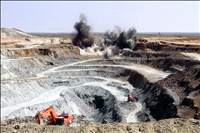India is poised to equal China as a global leader in the renewable energy transformation, a US-based research institute said on Tuesday.

Half of the world’s 10 largest solar parks under construction are in India, says a report by the Institute for Energy Economics and Financial Analysis (IEEFA).
India doubled solar installations to 10 GW in 2017-18 and is rapidly scaling up capacity towards achieving an ambitious and transformational 100 GW of solar by 2022, IEEFA director Tim Buckley said.
Since its big entry a decade ago, China has led the global solar energy industry. A massive manufacturing sector that has driven down costs and supportive government policies have helped it become the world’s largest producer of solar energy.
Neighbour India may have come to the party a little late, but is now racing ahead in terms of big projects.
India's scheme for development of solar parks is becoming a successful model to attract foreign capital, says the report titled Solar is Driving a Global Shift in Electricity Markets.
The world's largest solar project at 2,225 megawatt (MW) is under construction at the Bhadla Industrial Solar Park in Rajasthan.
This is more than double the largest fully operational solar park in India, which is the 1,000 MW Kurnool Ultra Mega Solar Park in Andhra Pradesh.
Also on the cards is a massive 5,000 MW solar park along the Gulf of Khambhat in Gujarat.
China still has the largest solar parks. Its 1,547 MW Tengger Desert Solar Park is the world’s biggest so far, but will be overtaken by Bhadla.
The year 2017 saw the commissioning of the world's largest floating solar project, Sungrow's 40 MW park in Anhui Province in China. Two 150 MW floating solar projects are due for commissioning in China in 2018.
Given land constraints, India's new policy target for 10,000 MW of floating solar nationally is a logical and commendable initiative to leverage this new innovation to enhance solar application and value proposition, said the report.
The report details some of the world's largest utility-scale, concentrated solar power, rooftop solar, floating solar, solar with battery storage projects, corporate renewable power purchase deals and utilities that lead on the renewable energy front.
Even for rooftop solar installation, India has gone big. A 19 MW system installed on an 82-acre campus of the RSSB Educational and Environmental Society in Amritsar, Punjab, is currently the world’s largest
“India has pioneered the concept of the ultra mega power plant (UMPP) in a single solar industrial park. This approach has been instrumental in driving economies of scale and procuring global capital flows … over the last two years with an immediate boon in the form of a halving of solar tariffs to a record low of Rs2.44 (per unit),” the IEEFA report said.
Bloomberg New Energy Finance reports global solar installations total 98 GW in 2017, 31 per cent more than the previous year. China installed 53 GW in 2017, over half the global total deployed in 2017.
"As major corporations sign on to such deals, they continue to look to 'green' their entire supply chains, many of which sit in emerging markets. This activity helps expand access to capital in markets, which is often a key constraint," report co-author Kashish Shah said in a statement.
India's National Electricity Plan aims to reduce thermal power from 67 per cent of capacity in 2017 to just 43 per cent by 2027.
Experts say major solar energy tenders are being floated every week in India at prices now consistently 10-20 per cent below the cost of existing domestic thermal power generation and 50 per cent below new imported coal-fired power.
In a major endorsement of India's solar mission, Tata Power this month embraced renewables as the way forward with a $5-billion plan, like the National Thermal Power Corp.
"Banks clogged with thermal power plant bad debts won't keep lending to this stranded asset sector; painful for India, but a positive for the transition to renewables," Buckley told IANS.
The largest power plant in India, Adani's Mundra 4.6 GW import coal plant, has been turned off since February 2018, being unviable to run, along with Tata's Mundra 4 GW imported coal plant, a $9-billion stranded asset.
 Half of the world’s 10 largest solar parks under construction are in India, says a report by the Institute for Energy Economics and Financial Analysis (IEEFA).
Half of the world’s 10 largest solar parks under construction are in India, says a report by the Institute for Energy Economics and Financial Analysis (IEEFA).

















.jpg)










